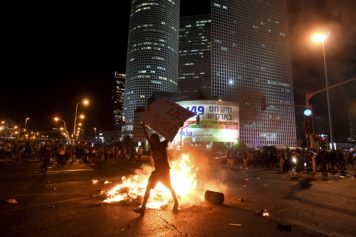“We left all our property – our home, our goats and chickens. I ran out and this is all that I have,” Nyakuom Tongyik says, pointing to the floral dress and pink scarf she is wearing. The 22-year-old is one of more than 70,000 refugees who have crossed the border into Ethiopia, fleeing fighting and devastation in South Sudan.
Her husband and father were killed when clashes erupted in their home town of Malakal, she says, sitting in her cramped, hot, white tent at Leitchor refugee camp in Gambella, western Ethiopia. She escaped with two of her children, but was separated from the third amid the chaos. During the 20-day walk to the Akobo border, Tongyik’s daughter fell sick. “She died on the way,” she says. “There was no way to get her to the hospital.”
Gambella, one of the poorest regions in one of the most food-insecure countries, was home to more than 76,000 asylum seekers from South Sudan when fighting erupted in Juba in December. The UN refugee agency, the UNHCR, is preparing to accommodate an influx of 150,000 refugees, but the government is concerned that the actual figure will be much higher.
“I don’t want to exaggerate, but maybe 300,000, maybe more than that because there is no food in South Sudan and the rains start in this region in May, so people will come to Ethiopia to seek refuge,” says Ayalew Aweke, deputy director of the Ethiopian Administration for Refugees and Returnees Affairs (Arra).
Refugees from South Sudan are also escaping south to Uganda and Kenya and north to Sudan, but with the onset of the rainy season, options will be limited and many more civilians will be driven towards Ethiopia. Transporting food and other supplies to the refugees will become more difficult and expensive as the few existing roads, many of them little more than dirt tracks, become impassable. Then there are the additional threats around sanitation and health – malaria, diarrhoea and cholera included.
Moses Okello, the UNHCR representative to Ethiopia, is aware of the pressing need to respond. “The rain is bringing to us an urgency, the need for us to act very, very quickly to get things in place where they are not.” In response, the World Food Programme is pre-positioning 1,530 tonnes of food in the region – enough to cover the needs of 80,000 refugees for one month. UNCHR is also trying to secure the use of helicopters to help move people and provisions before the rains begin.
About 95% of those seeking refuge in Ethiopia are women and children – an unusually high proportion. “I came with many women from the village. The men went to fight. We were only women,” Marsara Nyakuicak, a refugee from Gul Guk, South Sudan, says. Almost all the refugees interviewed had friends or relatives who had joined the rebel forces.
“We have heard reports of children as young as 14 and 15 being kept behind deliberately by the fighting forces on the South Sudan side,” says Dr Peter Salama, a representative of the UN children’s agency, Unicef, in Ethiopia.
The refugees deny forced conscription is taking place, but 19-year-old Kong Chul said he had been requested to join the White Army – a Nuer militia originally formed for cattle raiding – but no arms had been available to him.
Real the full story at theguardian.com


